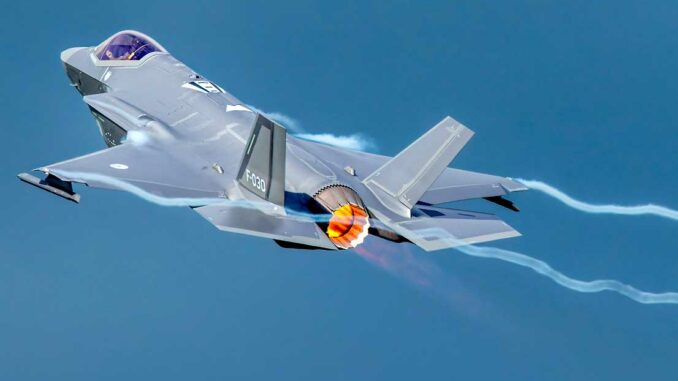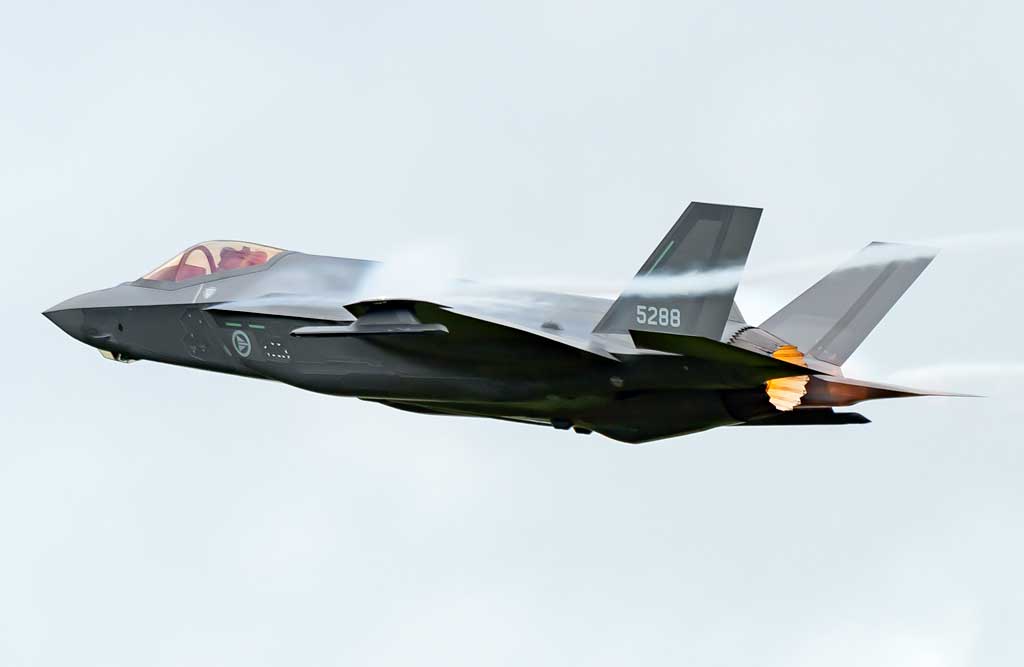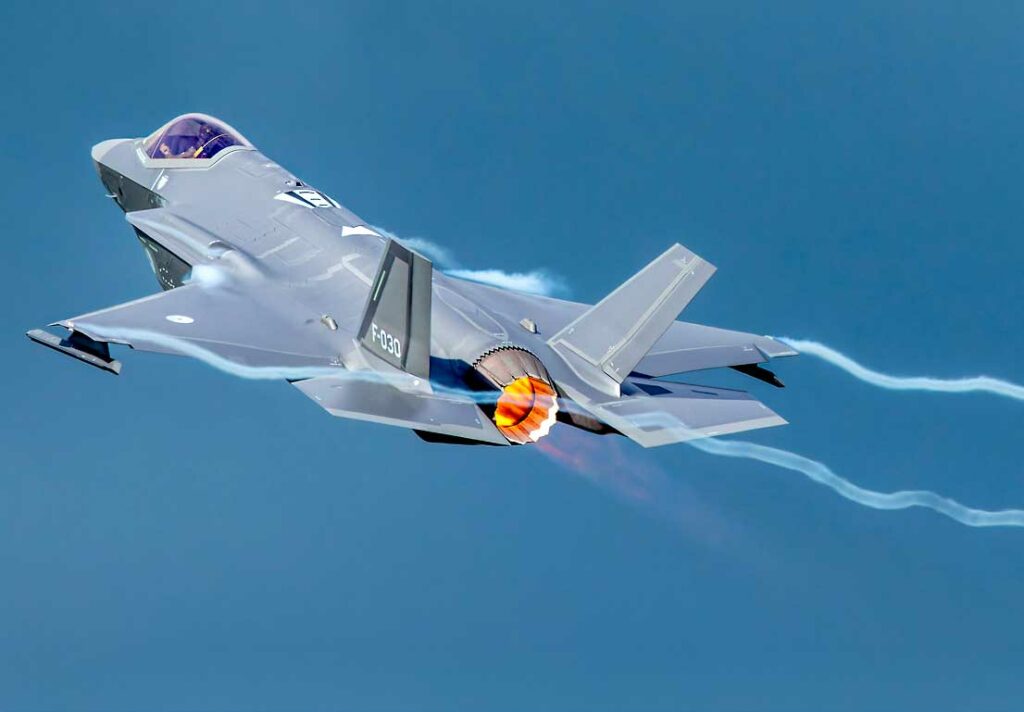
Germany is equipping its F-35As with stealthy JSMs, combining long-range strike capability, anti-ship functionality, and compatibility with the aircraft’s stealth profile.
Germany is preparing to arm its future F-35A fighter jets with Joint Strike Missiles (JSM) provided by Norway. Developed by Kongsberg Defence & Aerospace in partnership with Raytheon, the JSM is a discreet, long-range cruise missile designed to fit inside the internal bays of the F-35 without compromising its stealth capabilities. Capable of autonomously targeting land and naval objectives with precision, the JSM represents a major enhancement of Germany’s conventional strike capability, while also aligning with modern deterrence requirements.
A strategic boost through the JSM
Germany’s acquisition of the Joint Strike Missile (JSM) reflects a deliberate effort to overhaul its long-range strike capacity. The deal, valued at approximately \$645 million (around €600 million), includes an undisclosed number of missiles supplied by Norway via Kongsberg Defence & Aerospace. The contract was formally announced by Norwegian Defence Minister Tore O. Sandvik in the first half of 2025.
The JSM is derived from the Naval Strike Missile (NSM), an anti-ship missile already widely deployed (notably by the United States). In its air-launched JSM variant, the missile has been optimized for deployment from fighter aircraft and engineered to integrate seamlessly into the F-35A’s internal bays, a critical requirement to maintain the jet’s low observability.
With this decision, Germany becomes the fifth operator of the JSM, following Norway, the United States, Australia, and Japan. This move reflects a strategic convergence among NATO members toward interoperable, modular, and stealth-compatible weapons systems, in a context marked by rising regional tensions (Ukraine, the Baltic region, the Indo-Pacific).

A stealth missile technology tailored to the F-35
The Joint Strike Missile weighs 416 kg, is approximately 4 meters long, and carries a 118 kg warhead. Its range varies based on the flight profile: up to 555 km at high altitude, reduced to about 250 km in low-altitude penetration mode, which is designed to avoid enemy radar detection.
Technologically, the missile relies on a multi-sensor navigation system:
- INS/GPS for general trajectory tracking,
- TERCOM (terrain contour matching) to guide the missile in GPS-denied zones,
- Passive infrared (IIR) terminal seeker, undetectable by radar,
- Two-way data link, allowing mid-course updates or target reassignment in real-time.
These features make the missile resilient to electronic warfare, ensuring operational capability even in environments saturated with jamming—conditions seen in recent conflicts in Ukraine. Unlike other, more detectable air-to-ground missiles, the JSM maintains a minimal radar signature due to its materials and aerodynamic design. Its integration into the F-35A’s internal weapon bays allows the aircraft to penetrate contested airspace while remaining stealthy and conducting precision strikes at standoff distances.
Naval strike capability restored for the Luftwaffe
Since retiring its Kormoran missiles in the 2000s, the Luftwaffe has lacked onboard anti-ship capabilities. The arrival of the JSM enables Germany to re-establish this strategic function, at a time when threats in the Baltic and North Seas are multiplying.
The missile can engage surface ships, representing a doctrinal shift for an air force that had focused primarily on land-attack missions. The naval dimension of the JSM is essential given the growing presence of Russian naval forces in the Baltic Sea, particularly from Kaliningrad and the Barents Sea. The evolving threat environment calls for platforms capable of neutralizing maritime targets at a distance without exposing aircraft to dense anti-air defenses.
Germany’s decision to acquire this anti-ship capability also occurs within the framework of deepening bilateral cooperation with Norway, which already includes joint programs on Type 212CD submarines, the upcoming 3SM Tyrfing missile, and logistical sharing for NSM stocks.
Complementarity with other long-range missiles
In parallel with the JSM, Germany has also announced plans to procure 75 AGM-158B JASSM-ER (Extended Range) missiles, manufactured by Lockheed Martin. These weapons have a range of 925 km but cannot be carried internally by the F-35A due to their size. This limitation requires external carriage, which significantly reduces the stealth signature of the aircraft.
The JASSM-ER is a dedicated air-to-ground missile, in contrast with the more versatile JSM that can engage both land and sea targets. Germany is also considering a modernization of its Taurus missile, through a variant known as Taurus Neo, compatible with the Tornado and potentially the Eurofighter.
This gives rise to a three-pronged strike package: the JSM (stealthy and modular), the JASSM-ER (ultra-long range), and the future Taurus Neo (adaptable platform use). Together, they offer a powerful conventional projection capability across a range of missions—from European theaters to out-of-area NATO operations.

Accelerated military modernization in the post-Ukraine context
Since Russia’s invasion of Ukraine, Germany has undergone a dramatic shift in defense policy. Long criticized for underinvesting in its armed forces, Berlin has released a €100 billion special fund to upgrade the Bundeswehr, whose operational readiness had significantly declined.
The purchase of 35 F-35As, to be delivered by 2030, is part of this transformation. These aircraft will progressively replace the aging Tornado fleet, while retaining their dual role: conventional strike and NATO nuclear sharing (using U.S. B61 gravity bombs). This allows the Luftwaffe to maintain nuclear deterrence continuity without relying on American aircraft or on a speculative nuclear-capable Eurofighter.
By integrating missiles like the JSM, Germany can fully exploit the F-35A’s capabilities, well beyond its nuclear mission. This reflects a doctrinal shift aimed at bolstering strike depth, technological resilience, and operational autonomy within NATO’s European pillar.
Toward a sovereign European strike architecture?
The announcement of a German-British program for a deep-precision strike missile, with an expected range of 2,000 km, shows that Germany’s ambitions extend beyond the F-35 and existing missile purchases. The country aims to establish, over the medium term, a sovereign European capability, similar to the Franco-British FC/ASW (Future Cruise/Anti-Ship Weapon) project.
The missile being developed jointly by Berlin and London is intended to replace the Storm Shadow, SCALP-EG, and potentially the Taurus, offering a joint response to the threat posed by long-range Russian systems such as the Iskander, S-400, and Bastion.
In this context, the JSM serves as a readily operational intermediate step in a broader capability acceleration strategy. It gives Germany access to a reliable, field-proven, and immediately usable tool, while awaiting more ambitious European developments.
War Wings Daily is an independant magazine.